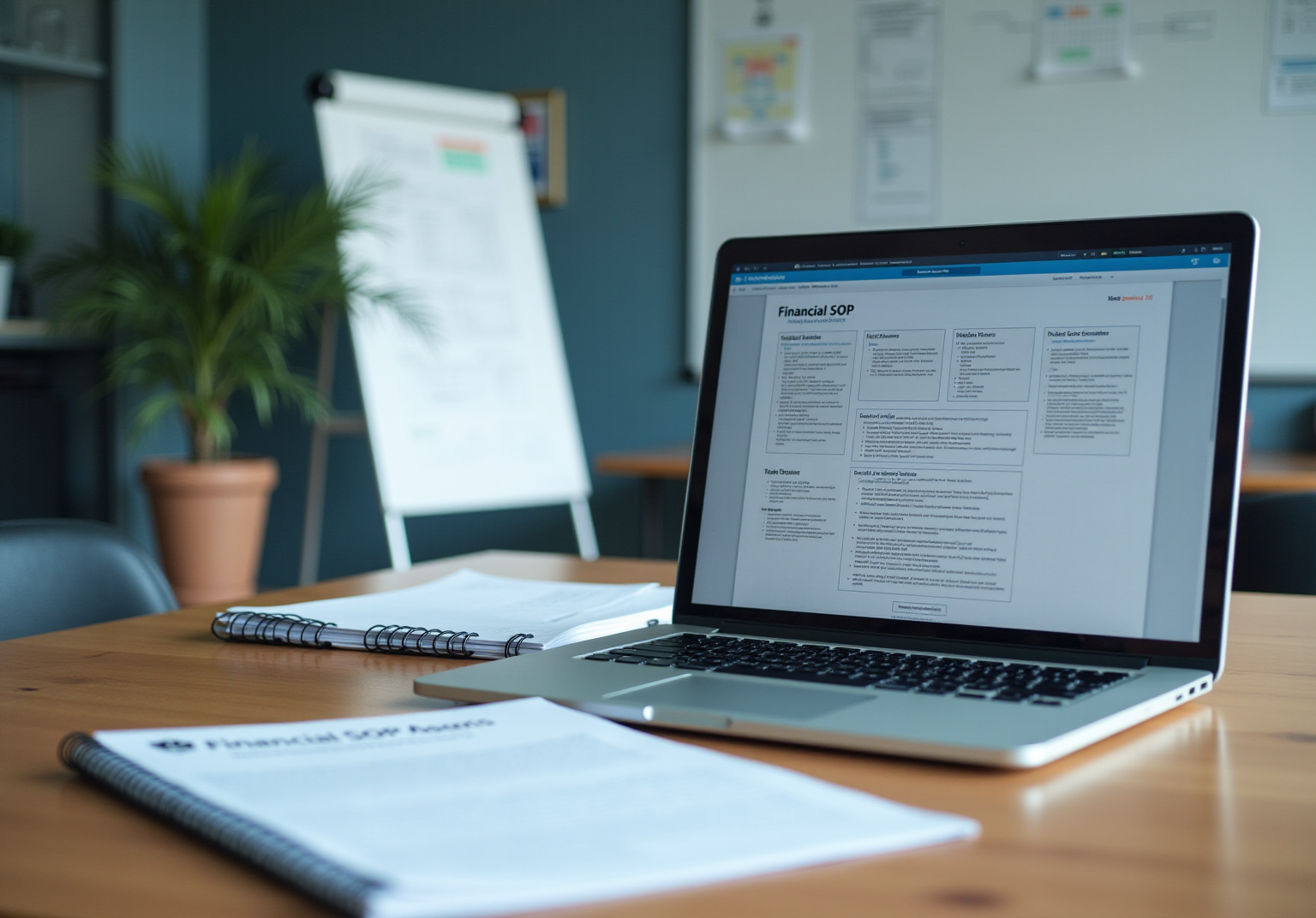
Success Stories in Documentation
|
October 18, 2025
|
10 Steps to Create an Effective Accounting SOP Template
Overview
You might be wondering how to create an effective accounting Standard Operating Procedure (SOP) template. Well, this article is your go-to guide! It highlights the importance of:
- Clarity
- Getting stakeholders involved
- Keeping everything up to date
By breaking it down into ten essential steps—like defining the SOP's scope, gathering relevant data, and analyzing usage metrics—you'll see how these elements can boost compliance, cut down on errors, and enhance operational efficiency in your organization.
So, let’s dive into these steps and explore how they can make your documentation process smoother and more effective!
Key Highlights:
- SowFlow provides a tool for quickly creating accounting SOP templates, enhancing documentation efficiency.
- Defining the SOP's scope is crucial to prevent vagueness and align with organisational goals.
- Organisations with clear SOP boundaries report up to 30% fewer errors, improving compliance and efficiency.
- Gathering relevant data from colleagues and existing documentation is essential for practical SOP creation.
- Choosing a structured format with headings, bullet points, and visuals boosts usability and retention.
- Involving stakeholders in the review process enhances accuracy and fosters ownership of the SOP.
- Publishing SOPs in a centralised system ensures easy access and facilitates quick updates.
- Promoting the SOP through training and onboarding encourages usage and integration within the organisation.
- Regular reviews and amendments keep the SOP relevant and compliant with current practises.
- Analysing usage metrics like completion and error rates helps assess the SOP's effectiveness.
- Incorporating practical examples enhances understanding and applicability of the SOP.
Introduction
Creating an effective accounting standard operating procedure (SOP) template can really boost your organization’s efficiency and compliance. You might be wondering how that’s possible. Well, with the right strategies in place, teams can streamline their financial processes, cut down on errors, and bring clarity to operations. But here’s the catch: many organizations find it tough to document these procedures in a way that makes sense. So, how can businesses ensure their accounting SOPs are not just thorough but also easy to use and flexible enough for changing needs?
Let’s explore ten essential steps to create a strong accounting SOP template, packed with valuable insights and practical tips to help you succeed.
SowFlow: Instant Creation of Accounting SOP Templates
You might be wondering how to make documenting financial processes a breeze. Well, SowFlow has got you covered with a fantastic documentation tool that lets you whip up accounting SOP templates in no time. By harnessing some pretty advanced technology, SowFlow takes the hassle out of documenting financial workflows. This means your team can create detailed guides without getting bogged down in the usual time-consuming tasks.
Not only does this nifty tool boost productivity, but it also ensures that all your financial activities are standardized and super easy to access. Imagine how much smoother your operations could run! So, why not give it a try and see how it can transform your documentation process?
Define the Scope: Establish Clear Boundaries for Your SOP
Defining the scope of your accounting SOP template is crucial for maintaining clarity and efficiency. You might be wondering what activities this SOP should cover—think invoicing, payroll, or financial reporting. By being specific, you help users know exactly what to expect, which prevents the SOP from becoming too broad or vague. A well-defined scope not only aligns the SOP with your organization's goals but also meets compliance requirements, reducing the risk of errors and miscommunication.
Did you know that organizations with clearly defined SOP boundaries report up to 30% fewer errors in their processes? That’s a significant reduction in operational inefficiencies! For example, a logistics company managed to improve compliance and cut down on errors just by logically organizing its SOPs. It really shows how effective clear boundaries can be.
Operations managers often stress the importance of clarity. One manager pointed out, "Clear SOPs lessen friction between groups and remove confusion, making sure everyone is on the same page." And Anna Taylor echoes this sentiment, saying, "Clear SOPs also reduce friction between groups and eliminate confusion." It’s clear that clarity in SOPs is key!
To set these boundaries effectively, consider involving your team in the SOP creation process. Regularly reviewing and updating the SOP to reflect any changes is also a good practice. Plus, using an accounting SOP template can help maintain consistency across your documentation. Tools like SweetProcess can be a huge help in creating and managing these SOPs effectively.
By putting these strategies into action, you can build strong financial SOPs, particularly an accounting SOP template, that boost productivity and ensure compliance, ultimately leading to better operational performance.
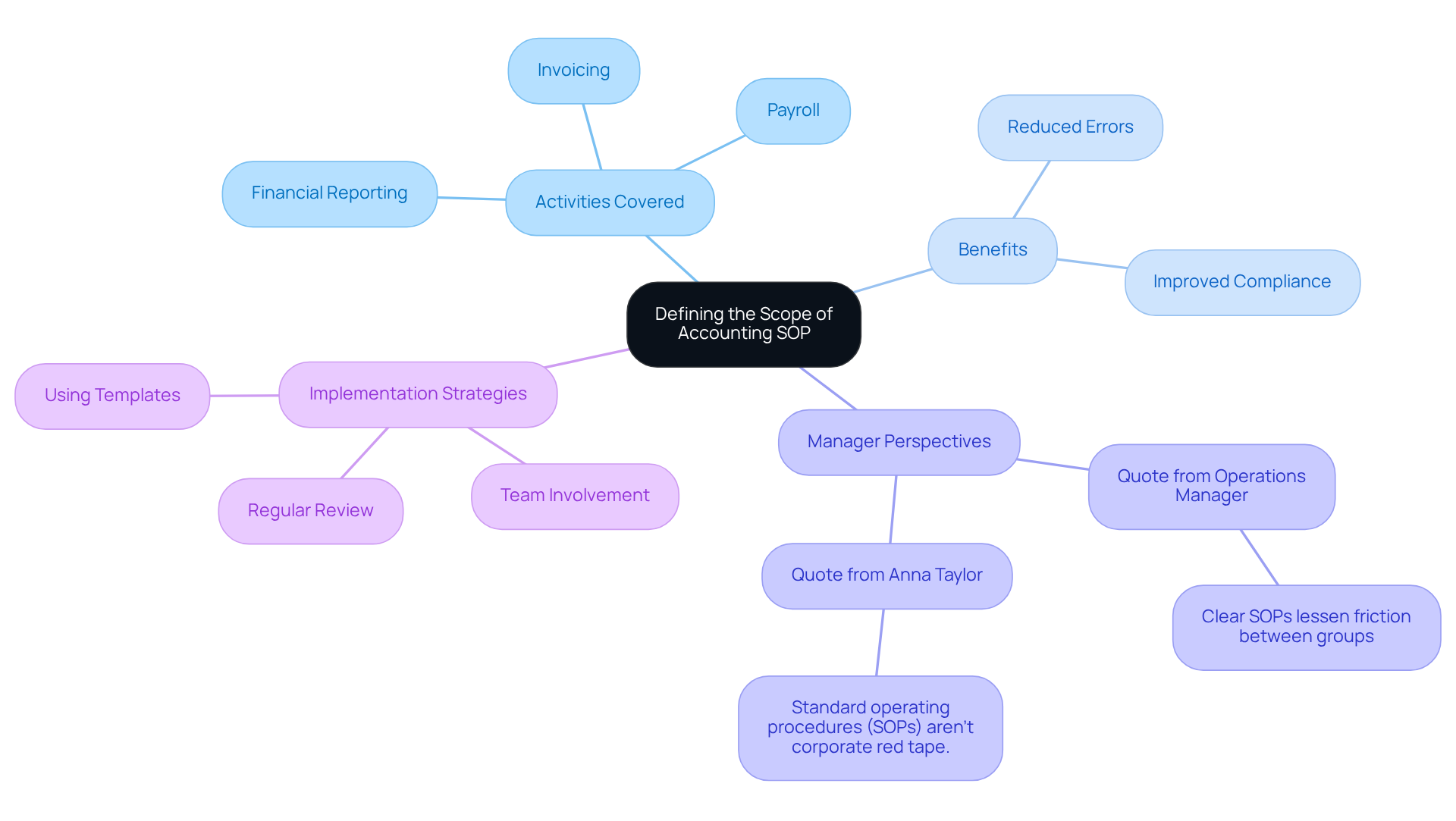
Gather Information: Collect Relevant Data for Your SOP
You might be wondering how to kickstart your accounting SOP template. Well, gathering relevant information is a crucial first step! With SowFlow's instant documentation solution, accessing and updating your existing guides is a breeze, making sure your team has the latest info right at their fingertips.
- Have a chat with your colleagues.
- Dive into the existing documentation.
- Take a good look at current workflows to gather data that truly reflects your processes.
This info will be the backbone of your accounting SOP template, ensuring it’s practical and applicable, while also giving your team the tools they need for smooth workflow sharing. Now, let’s dive into how to make this process even easier!
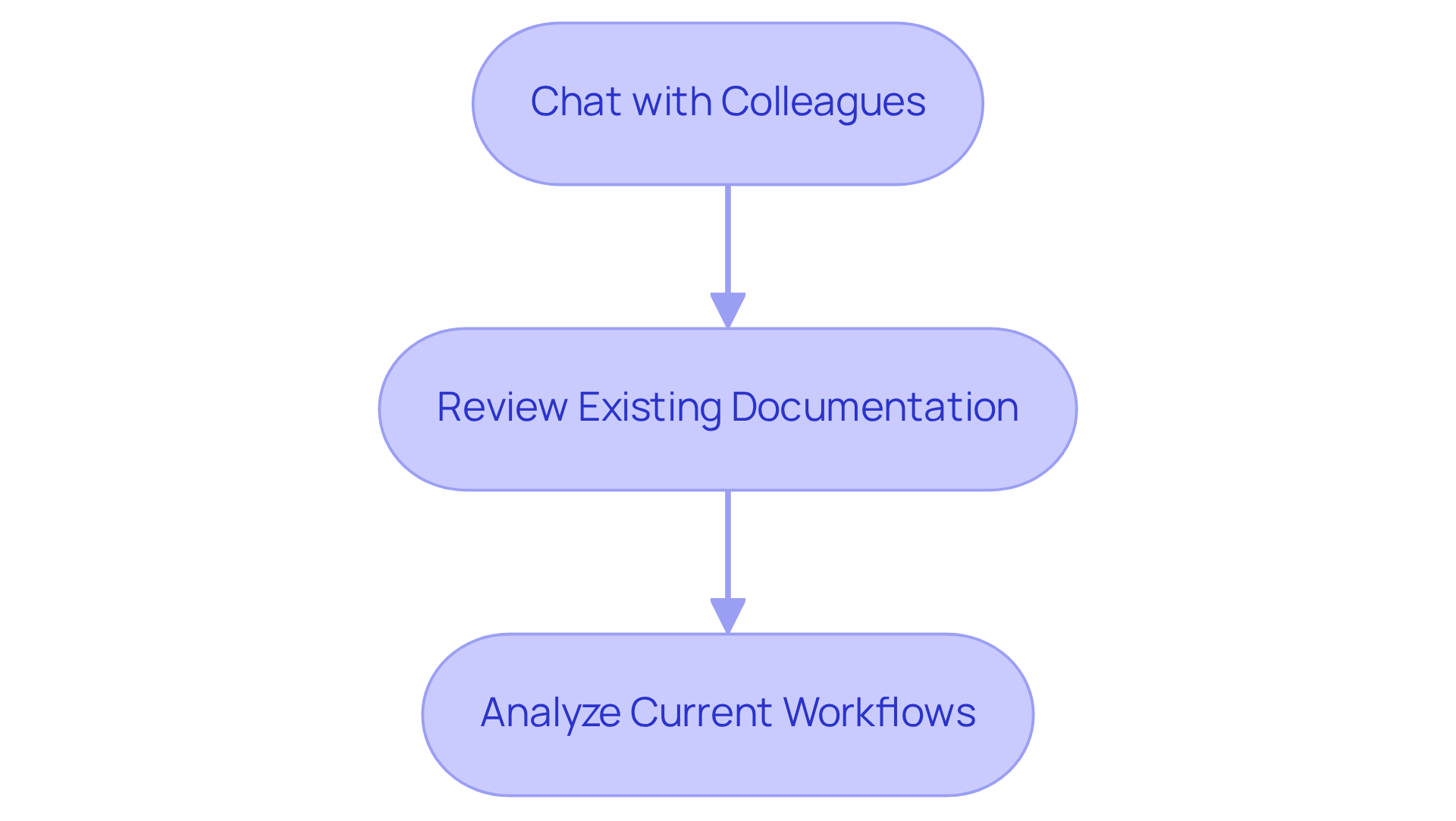
Choose the Format: Select an Effective Layout for Your SOP
You might be wondering how to choose the right layout for your accounting SOP template. Well, it's super important for maximizing usability and ensuring clarity! A structured format that includes:
- Headings
- Bullet points
- Numbered lists
can really help break down complex procedures into manageable steps, making it easier for everyone to follow along. Plus, adding visual aids like flowcharts or diagrams can significantly boost understanding and retention of information. As Suzanna Daniel pointed out, "Businesses require a well-structured system for recording methods, procedures, and policies that guarantee consistency and reliability in their accounts and financial operations."
Now, here’s something interesting: research shows that well-organized SOPs lead to higher user engagement. Why? Because they allow employees to quickly find relevant information and follow procedures with confidence. For instance, did you know that structured SOPs can actually reduce training time for new hires by providing clear instructions? By prioritizing a clear and organized layout in their accounting SOP template, organizations can promote better compliance and efficiency in their financial operations. So, what do you think? Are you ready to dive into creating a more effective SOP?
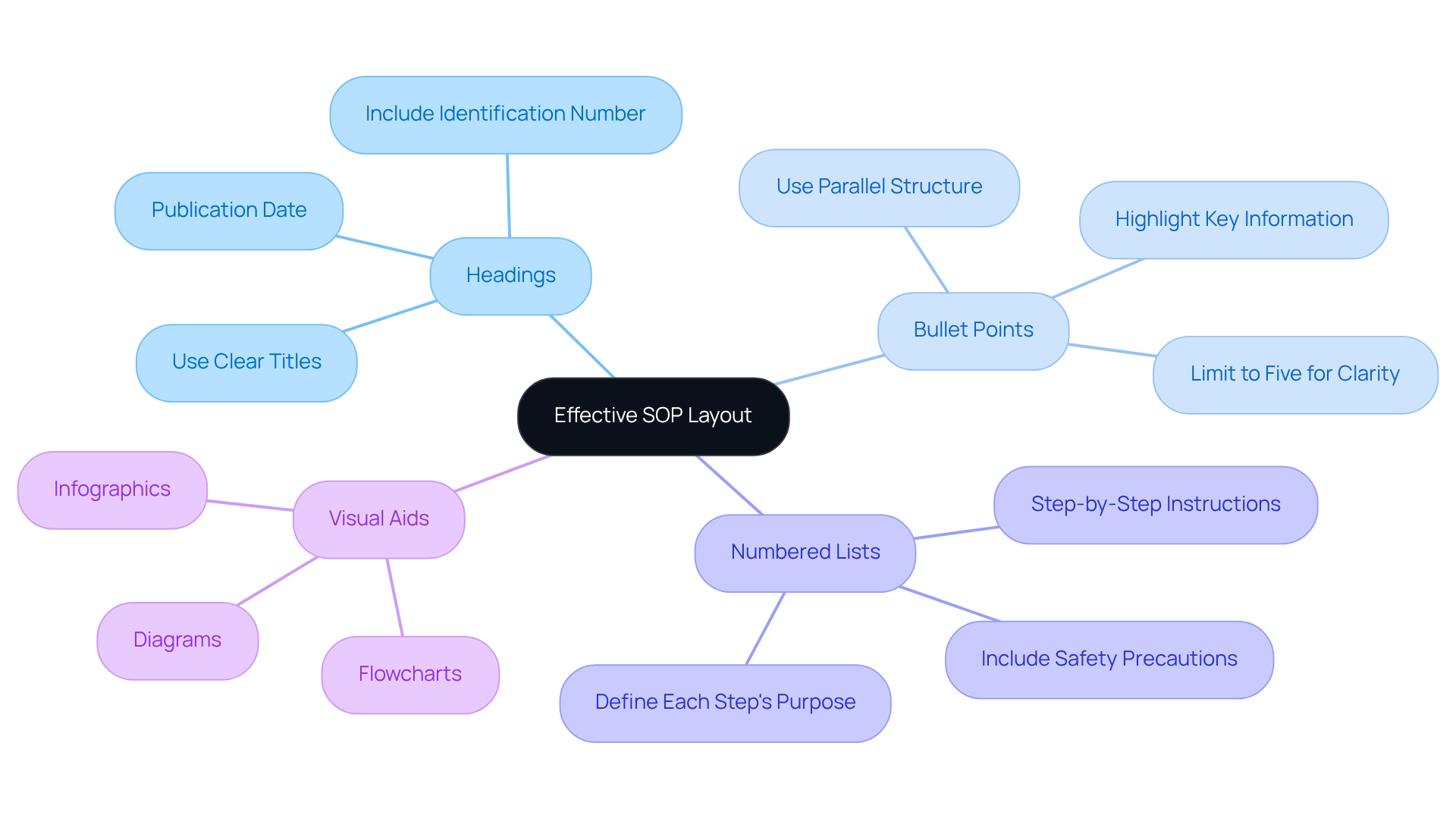
Review with Stakeholders: Validate Your SOP for Accuracy
You might be wondering why involving stakeholders in the review phase is such a big deal. Well, it’s essential for ensuring that your accounting SOP template is both precise and efficient. By sharing the draft with group members, managers, and other relevant folks, you open the door to comprehensive feedback that really boosts the quality of the document. This collaborative approach doesn’t just enhance the content of the accounting SOP template; it also fosters a sense of ownership among users, which leads to better adherence and implementation.
Research backs this up—SOPs that get the thumbs up from stakeholders show significantly higher accuracy rates. In fact, studies reveal that organizations using collaborative review methods report up to 30% fewer errors in their documentation. Take, for instance, a well-known financial company that revamped its financial procedures by incorporating group input. The result? An improved system that not only increased compliance but also minimized inconsistencies.
Operations managers often highlight the importance of these collaborative review processes. They point out that such practices promote transparency and accountability among teams, ultimately leading to more effective operational practices. So, why not consider bringing your stakeholders into the mix? It could make a world of difference!
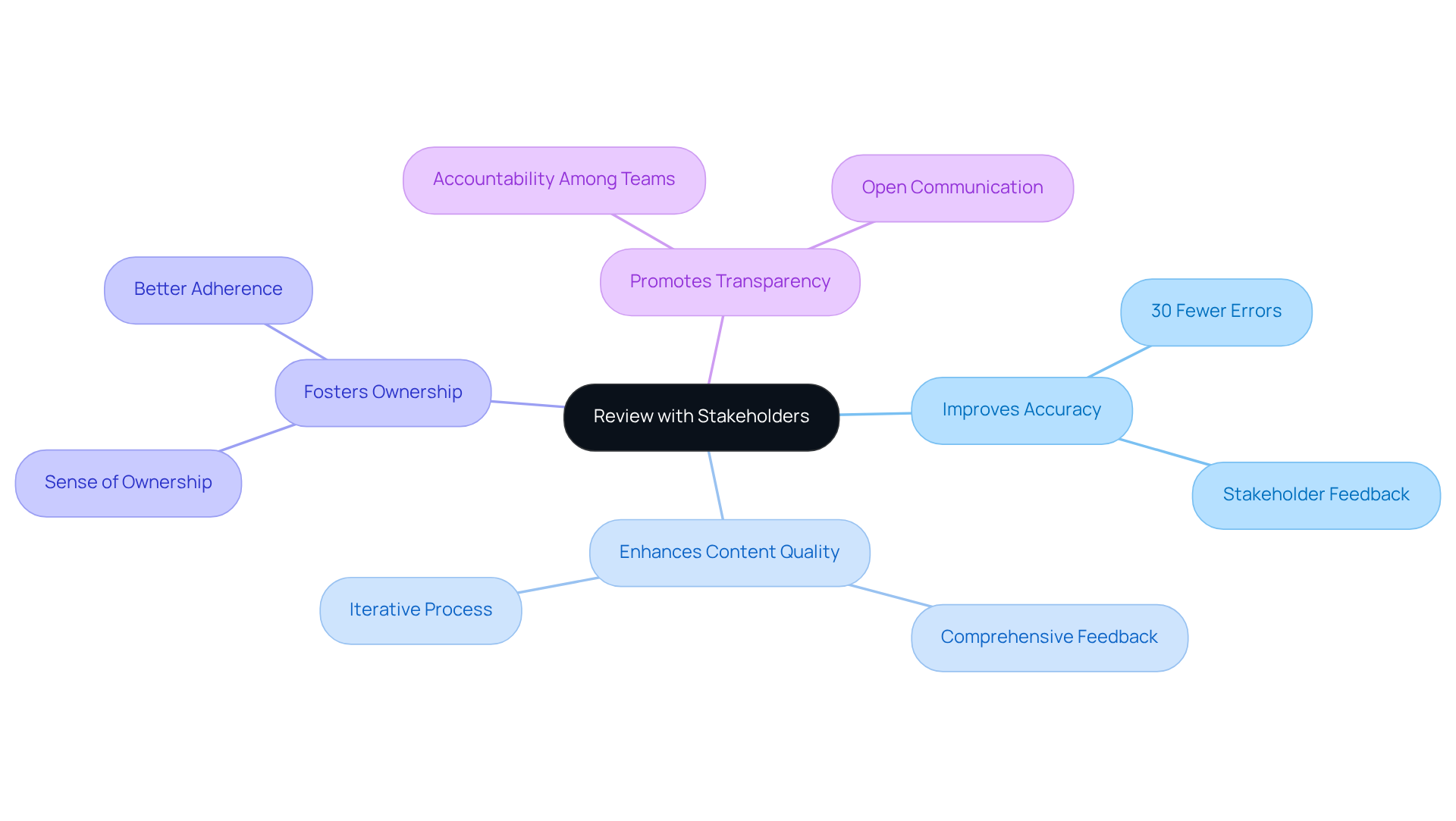
Publish Your SOP: Make It Accessible to All Users
So, you've finally wrapped up your financial SOP—what's next? Well, it's time to get it out there! With SowFlow, you can make sure that everyone has easy access to the SOP through a centralized document management system, intranet, or shared drive. This way, your team can grab the documentation they need in a snap. Plus, SowFlow really empowers teams by allowing for quick updates and revisions. Imagine being able to access all that valuable information with just a single command!
Now, you might be thinking, 'How do I keep track of all these updates?' That's where version control comes in handy. It helps you keep tabs on changes and ensures that everyone is working from the most current version. This not only boosts productivity but also cuts down on those endless meetings where everyone’s trying to figure out what’s what. So, why not give it a try and see how it can streamline your workflow?
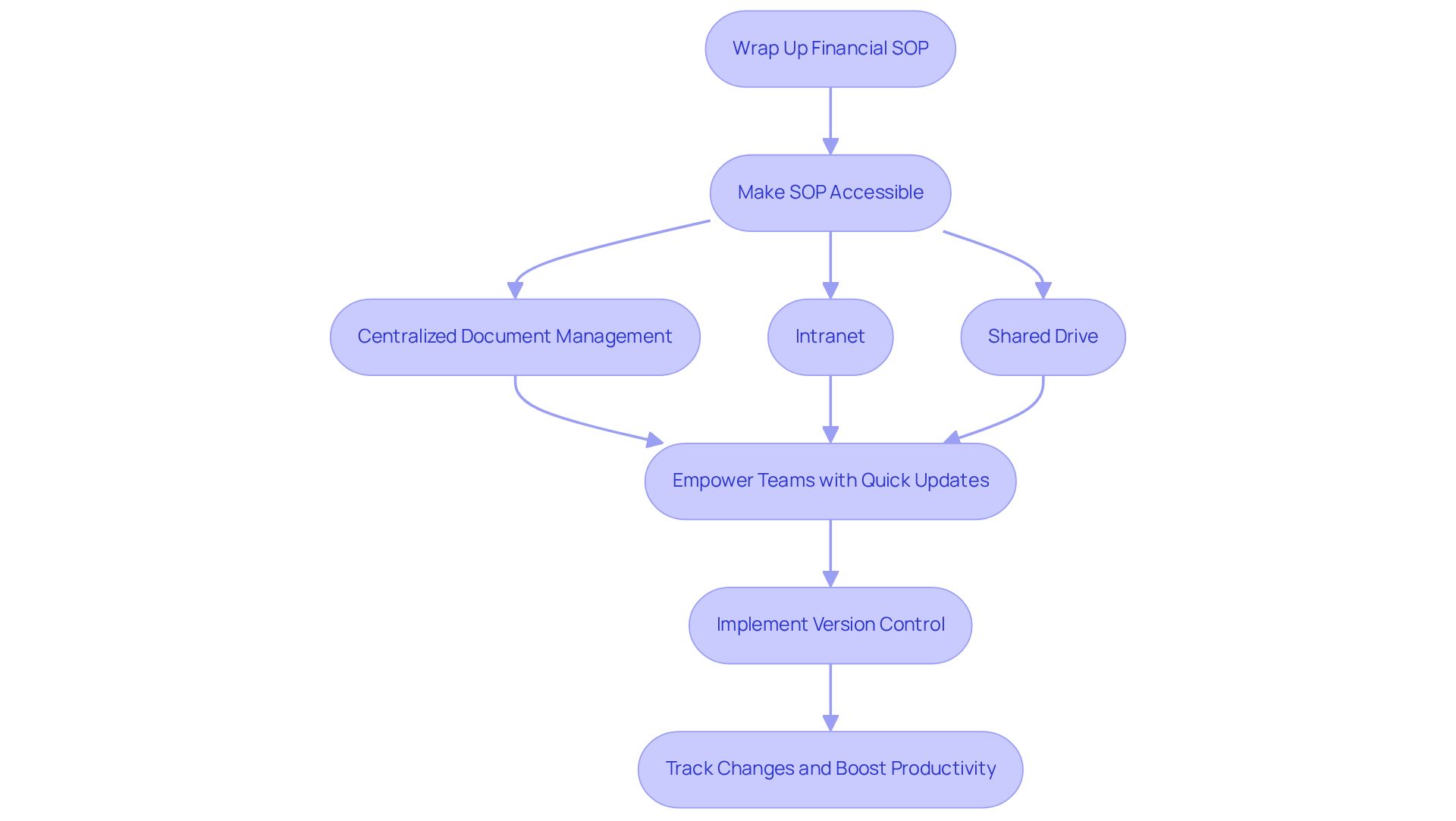
Promote Your SOP: Encourage Usage Across the Organization
To make the most of your accounting SOP template, you’ll want to ensure that everyone is on board with using it. Have you thought about conducting some training sessions? Sharing announcements and weaving the SOP into onboarding for new hires can really help. Plus, highlighting the perks of using the accounting SOP template—such as boosting efficiency and reducing errors—can encourage your team to embrace it.
As Anastasia Masadi, a Product Owner, puts it, "SowFlow has transformed the way we document work and deliver to our clients. I can create SOPs and training materials without leaving the browser or taking each screenshot separately, which has saved me valuable time."
This really shows how using SowFlow not only makes creating SOPs easier but also helps in promoting and integrating these vital documents within your organization. So, why not start the conversation about it today?
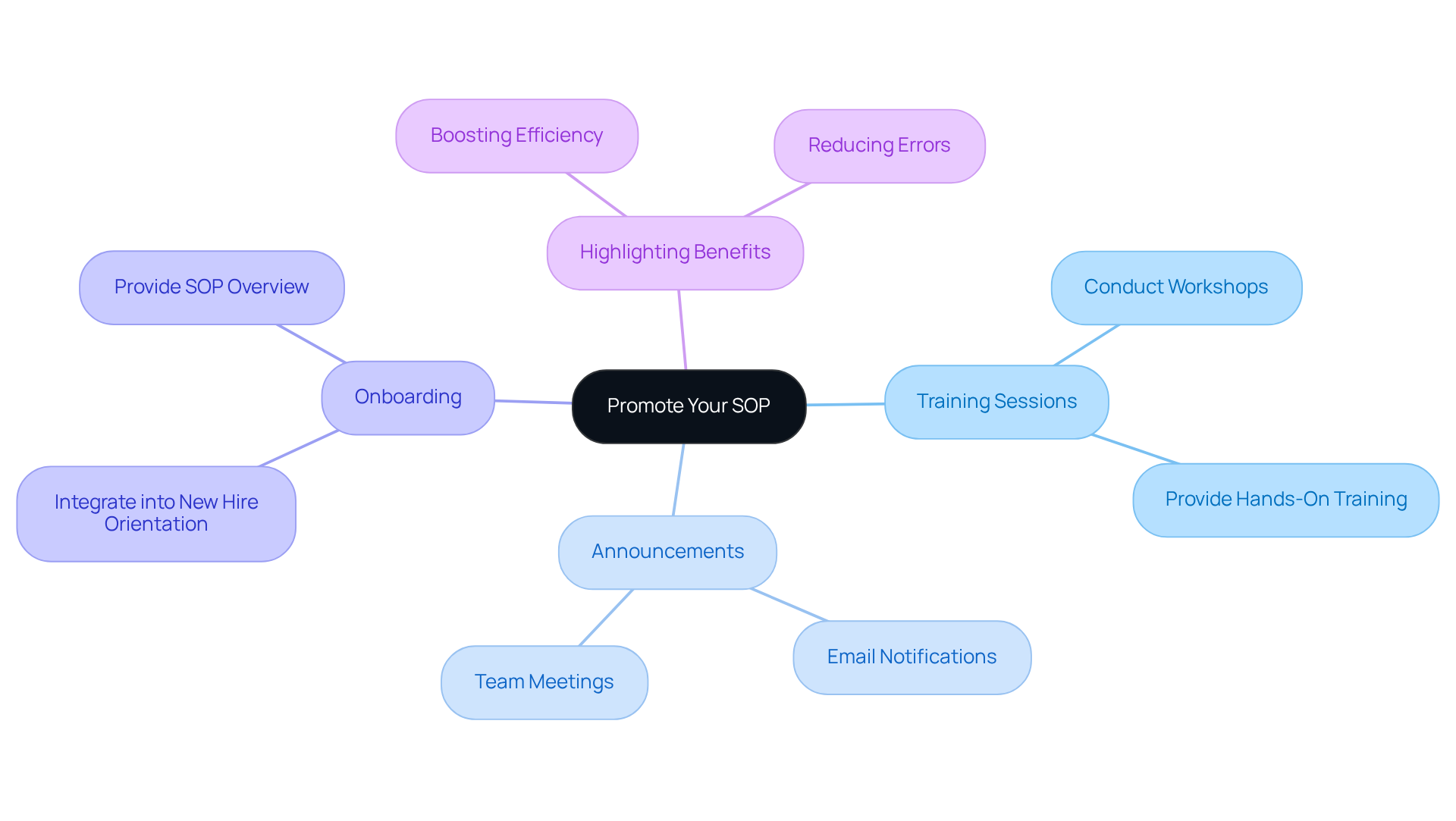
Review and Amend: Keep Your SOP Up-to-Date
You might be wondering how to keep your standard operating procedure (SOP) fresh and relevant. Establishing a routine for reviewing and amending your SOP is key! Consider scheduling regular check-ins—maybe quarterly or biannually—to see if the SOP still matches what’s actually happening on the ground and meets those pesky regulatory requirements.
And don’t forget to incorporate feedback from users; their insights can lead to valuable updates and improvements. So, let’s dive into how you can make this process work for you!
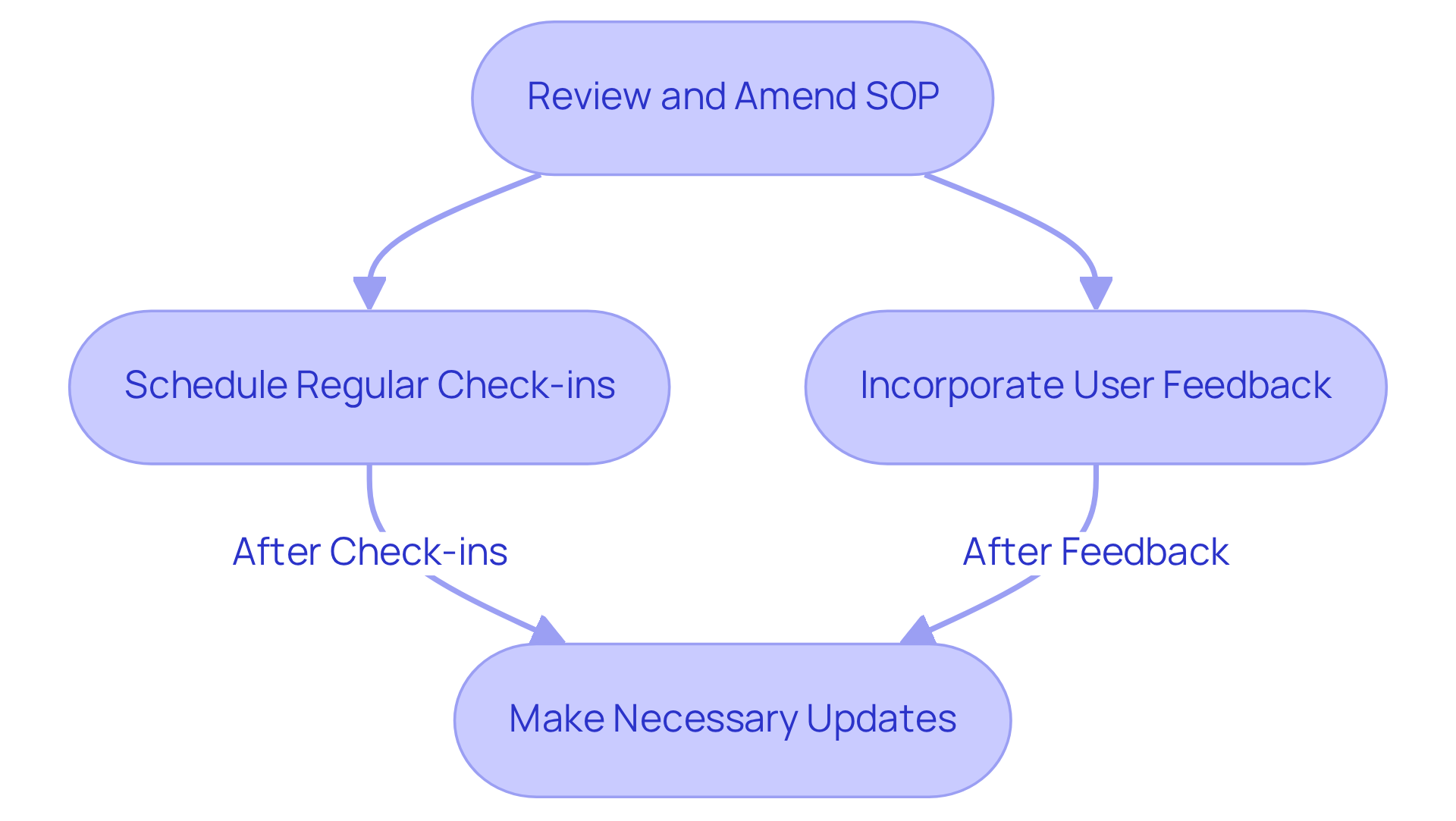
Analyze Usage Metrics: Assess the Effectiveness of Your SOP
You might be wondering how to truly evaluate the effectiveness of your financial SOP. Well, it’s all about diving into some key metrics like:
- Completion rates
- User feedback
- Error rates
These insights can really shine a light on how well the SOP is being followed and where you might need to make some tweaks. So, why not use this information to refine the SOP and boost its impact on your operational efficiency? It’s a great way to ensure everything runs smoothly!
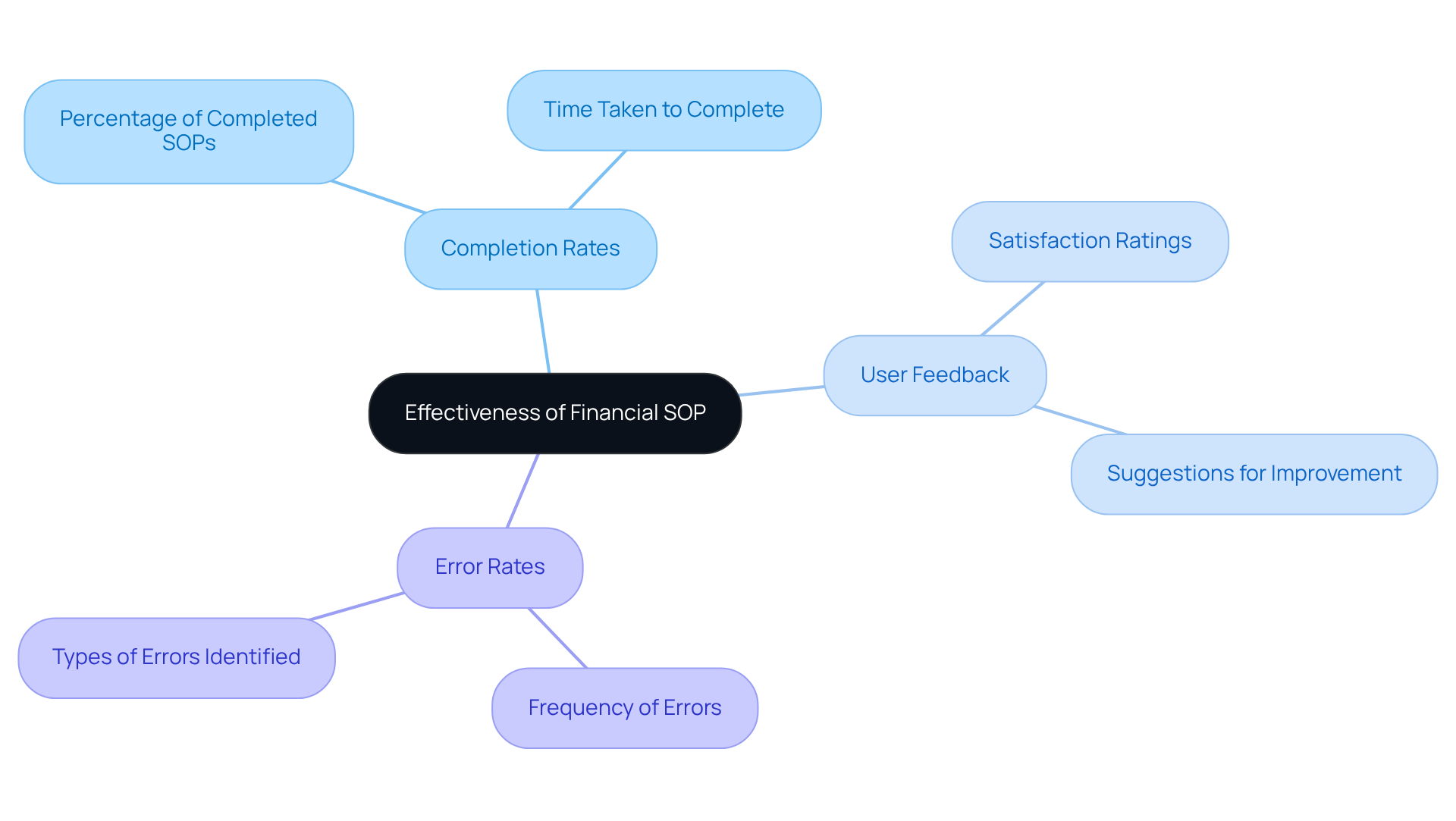
Include Examples: Enhance Clarity with Practical Scenarios
You might be wondering how to make your financial SOP even clearer. Well, incorporating practical examples and scenarios can really help! These examples illustrate how to apply the procedures in real-world situations, making it so much easier for you to grasp the concepts and follow the steps outlined in the SOP.
Consider using case studies or hypothetical situations that reflect the common challenges you might face in creating an accounting SOP template. By doing this, you not only enhance understanding but also make the whole process feel more relatable and manageable.
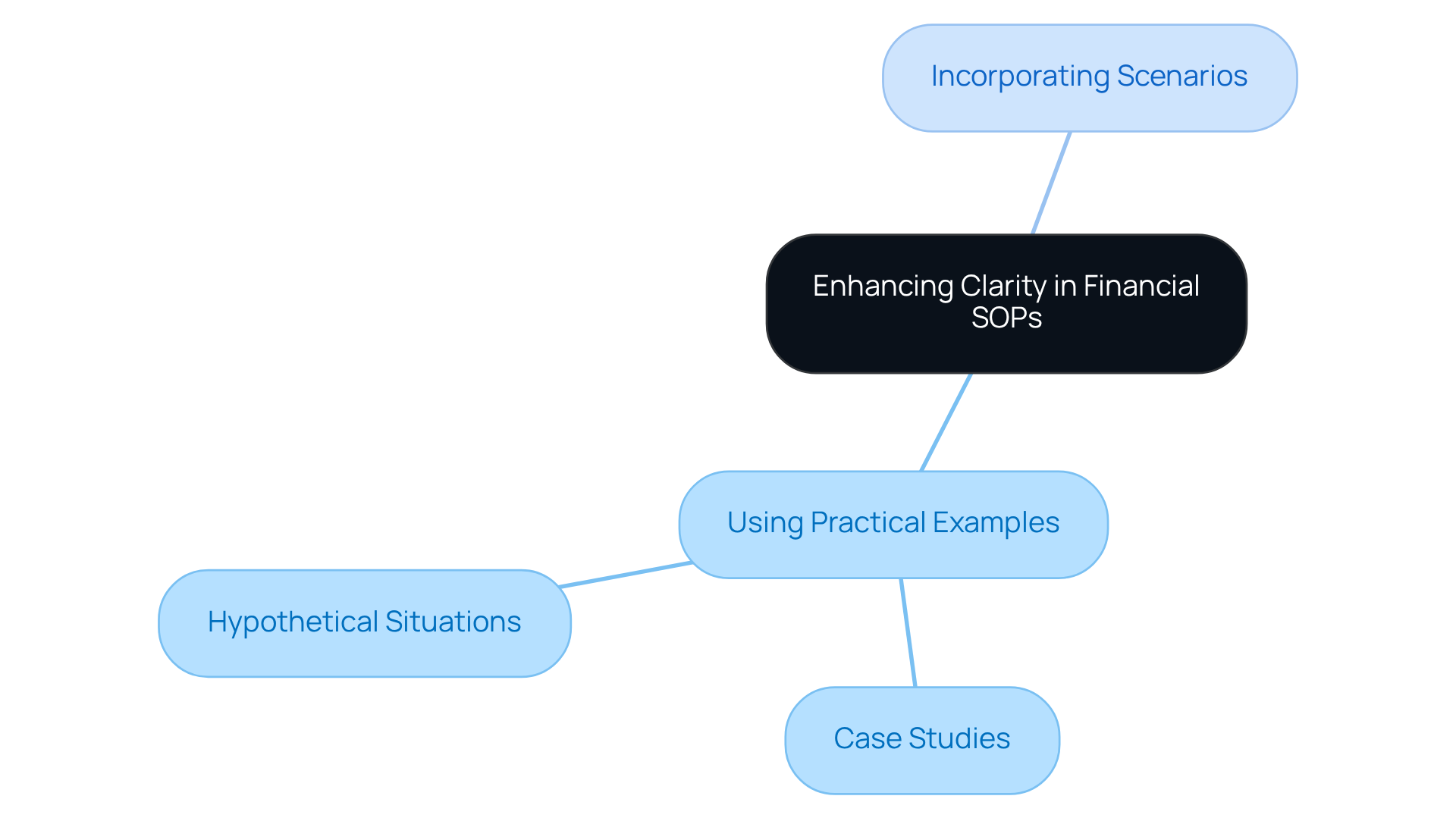
Conclusion
Creating an effective accounting SOP template is super important for making financial processes smoother and boosting productivity in your organization. You might be wondering how to get started. Well, by taking a structured approach—defining the scope, gathering relevant info, and promoting usage—you can make sure your SOPs are not just practical but also embraced by everyone. Tools like SowFlow are game-changers here, simplifying the documentation process so that teams can easily create, manage, and access these essential resources.
Now, let’s dive into some key strategies we discussed earlier. Clarity is crucial when defining the SOP's boundaries, and getting stakeholders involved in the review process is a must. Plus, using effective formats and examples can really enhance understanding. Each step—from publishing the SOP to analyzing its usage metrics—plays a role in building a comprehensive system that encourages compliance and minimizes errors. This all adds up to improved operational efficiency, which is what we’re aiming for!
In conclusion, we can’t stress enough how vital well-crafted accounting SOPs are. By embracing best practices and leveraging technology, you can foster a culture of accountability and clarity that empowers your team. Regular reviews and updates, along with practical examples, will keep these documents relevant and effective. So, why wait? Taking action now to refine and promote your accounting SOPs will set the stage for smoother operations and greater success in financial management.
Frequently Asked Questions
What is SowFlow and how does it assist in creating accounting SOP templates?
SowFlow is a documentation tool that allows users to quickly create accounting SOP (Standard Operating Procedure) templates. It utilizes advanced technology to simplify the process of documenting financial workflows, enhancing productivity and ensuring standardized access to financial activities.
Why is defining the scope of an accounting SOP template important?
Defining the scope is crucial for maintaining clarity and efficiency within the SOP. It helps specify which activities the SOP should cover, such as invoicing, payroll, or financial reporting, preventing the document from being too broad or vague. A well-defined scope aligns with organizational goals and meets compliance requirements, reducing the risk of errors and miscommunication.
How can clear boundaries in SOPs impact operational efficiency?
Organizations with clearly defined SOP boundaries report up to 30% fewer errors in their processes, leading to significant reductions in operational inefficiencies. Clear SOPs help lessen friction between groups and eliminate confusion, ensuring that everyone is aligned and on the same page.
What strategies can be employed to effectively define the boundaries of an SOP?
To effectively define SOP boundaries, involve your team in the creation process, regularly review and update the SOP to reflect any changes, and utilize an accounting SOP template to maintain consistency across documentation.
What steps should be taken to gather information for an accounting SOP template?
To gather relevant information for an accounting SOP template, you should: - Speak with colleagues to gain insights. - Review existing documentation to ensure accuracy. - Analyze current workflows to collect data that accurately reflects your processes.
How does SowFlow facilitate the gathering and updating of information for SOPs?
SowFlow's instant documentation solution allows for easy access to and updating of existing guides, ensuring that your team has the most current information readily available for creating practical and applicable accounting SOP templates.
👍
What others are liking
5 Steps to outline your ideal documentation structure
5 MINS READ
Where to start the your journey of mapping out your ideal documentation structure, aligning it with the very heartbeat of your organization?
Defining a winning level of detail in your process
3 MINS READ
What is too much detail, and what is too little? This article described in that winning level detail about what detail is enough.





